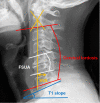The fatty infiltration into cervical paraspinal muscle as a predictor of postoperative outcomes: A controlled study based on hybrid surgery
- PMID: 36843584
- PMCID: PMC9946973
- DOI: 10.3389/fendo.2023.1128810
The fatty infiltration into cervical paraspinal muscle as a predictor of postoperative outcomes: A controlled study based on hybrid surgery
Abstract
Background: The cervical paraspinal muscle (CPM) has an essential role in positioning, stabilizing and directing the cervical spine. However, information is lacking regarding the influence of CPM on outcomes following anterior cervical surgery. This study aims to evaluate the association of fatty infiltration (FI) of CPM with postoperative outcomes in patients undergoing hybrid surgery (HS) and analyze the relationship between FI and cross-sectional area (CSA) of CPM.
Methods: A retrospective analysis was performed on 110 consecutive patients undergoing continuous 2-level HS. According to Goutallier classification of multifidus FI, the patients were divided into normal, moderate, and severe groups. Image J software was employed to outline and analyze CPM. Clinical outcomes and radiographic parameters were collected and evaluated for relevant comparisons.
Results: Visible FI was identified in 69.1% of patients (76/110), with a propensity in elderly patients (p = 0.053). No statistically significant differences were presented among the three groups regarding pre- and postoperative clinical evaluation scores. The cervical lordosis was significantly higher in the normal group before surgery (p = 0.029). Likewise, the sagittal vertical axis (SVA) was significantly higher in the severe group than the normal group at the final follow-up (p = 0.046). The function spine unit angle and disc angle of arthroplasty levels were significantly lower in the severe group than the normal group at follow-ups. Moreover, after correction according to vertebral body area, no statistically significant relationship existed between CSA ratio and FI grade.
Conclusion: CPM degeneration is common and age-related in patients with cervical disc degenerative disease. More importantly, there was a significant positive correlation between severe FI of CPM and postoperative sagittal balance disorder, particularly in C2-7 SVA and segmental alignment of arthroplasty level. Meanwhile, FI of CPM appears to have no impact on clinical outcomes and reveals small correlations to CSA.
Keywords: cervical disc degenerative disease; cervical paraspinal muscle; cross-sectional area; fatty infiltration; hybrid surgery.
Copyright © 2023 He, Wu, Ding, Wang, Hong and Liu.
Conflict of interest statement
The authors declare that the research was conducted in the absence of any commercial or financial relationships that could be construed as a potential conflict of interest.
Figures




Similar articles
-
Importance of the cervical paraspinal muscles in postoperative patient-reported outcomes and maintenance of sagittal alignment after anterior cervical discectomy and fusion.J Neurosurg Spine. 2024 May 3;41(2):149-158. doi: 10.3171/2024.2.SPINE23926. Print 2024 Aug 1. J Neurosurg Spine. 2024. PMID: 38701526
-
Paraspinal Muscle Parameters Predict Postoperative Sagittal Balance in Cervical Disc Arthroplasty: A Structural Equation Model Analysis.Spine (Phila Pa 1976). 2025 May 22. doi: 10.1097/BRS.0000000000005389. Online ahead of print. Spine (Phila Pa 1976). 2025. PMID: 40357868
-
Association Between Cervical Sagittal Alignment and Subaxial Paraspinal Muscle Parameters.Spine (Phila Pa 1976). 2024 May 1;49(9):621-629. doi: 10.1097/BRS.0000000000004897. Epub 2023 Dec 15. Spine (Phila Pa 1976). 2024. PMID: 38098290
-
Different degeneration patterns of paraspinal muscles in degenerative lumbar diseases: a MRI analysis of 154 patients.Eur Spine J. 2022 Mar;31(3):764-773. doi: 10.1007/s00586-021-07053-2. Epub 2022 Jan 3. Eur Spine J. 2022. PMID: 34978601
-
Imaging Evaluation of Fat Infiltration in Paraspinal Muscles on MRI: A Systematic Review with a Focus on Methodology.Orthop Surg. 2021 Jun;13(4):1141-1148. doi: 10.1111/os.12962. Epub 2021 May 4. Orthop Surg. 2021. PMID: 33942525 Free PMC article.
Cited by
-
Anterior bone loss after anterior cervical discectomy and fusion: influence factors and its impact on surgical outcomes.BMC Musculoskelet Disord. 2025 Jul 4;26(1):607. doi: 10.1186/s12891-025-08852-0. BMC Musculoskelet Disord. 2025. PMID: 40616042 Free PMC article.
-
Comparison of the effectiveness of zero-profile device and plate cage construct in the treatment of one-level cervical disc degenerative disease combined with moderate to severe paraspinal muscle degeneration.Front Endocrinol (Lausanne). 2023 Dec 6;14:1283795. doi: 10.3389/fendo.2023.1283795. eCollection 2023. Front Endocrinol (Lausanne). 2023. PMID: 38125794 Free PMC article.
-
Artificial intelligence in predicting postoperative heterotopic ossification following anterior cervical disc replacement.Eur Spine J. 2024 Nov;33(11):4082-4091. doi: 10.1007/s00586-024-08396-2. Epub 2024 Jul 29. Eur Spine J. 2024. PMID: 39073460
-
The role of paraspinal muscle degeneration in cervical spondylosis.Eur Spine J. 2025 Mar;34(3):1187-1197. doi: 10.1007/s00586-025-08648-9. Epub 2025 Jan 15. Eur Spine J. 2025. PMID: 39812789
-
Using Machine Learning Algorithms to Predict Postoperative Anterior Bone Loss Following Anterior Cervical Disc Replacement.Global Spine J. 2025 May;15(4):2236-2245. doi: 10.1177/21925682241293712. Epub 2024 Oct 15. Global Spine J. 2025. PMID: 39407406 Free PMC article.
References
-
- Okada E, Matsumoto M, Ichihara D, Chiba K, Toyama Y, Fujiwara H, et al. . Cross-sectional area of posterior extensor muscles of the cervical spine in asymptomatic subjects: a 10-year longitudinal magnetic resonance imaging study. Eur Spine J (2011) 20(9):1567–73. doi: 10.1007/s00586-011-1774-x - DOI - PMC - PubMed
Publication types
MeSH terms
LinkOut - more resources
Full Text Sources
Miscellaneous

